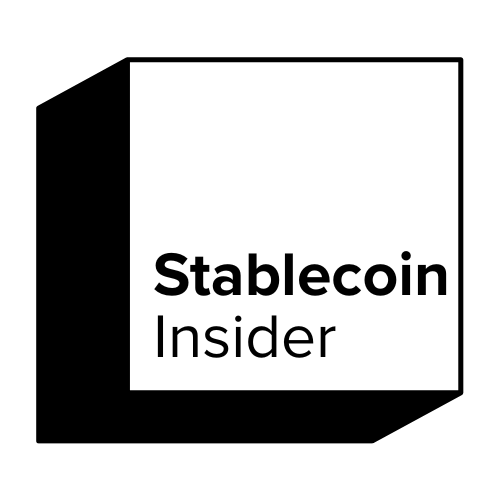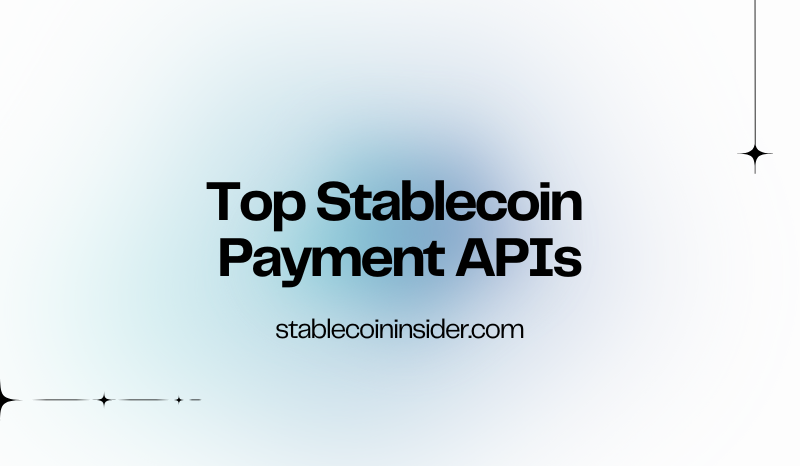Stablecoins are transforming the way money moves across the internet. As programmable, borderless, and fast-settling digital dollars, stablecoins are unlocking powerful new financial use cases.
But behind every seamless stablecoin transaction is an API making it all work—just like Stripe did for fiat payments.
Today, a new wave of companies is racing to become the “Stripe for stablecoins” by building developer-first APIs that abstract the complexities of crypto payments. These platforms are empowering businesses to integrate stablecoin transactions directly into apps, platforms, and financial services.
In this article, we’ll profile the top stablecoin payment APIs emerging in 2025, explore their key features, and examine how they’re onboarding developers and startups in the stablecoin economy.
Key Takeaways
- Stablecoin payment APIs simplify the process of sending, receiving, and managing crypto payments.
- APIs are a crucial layer for onboarding businesses and developers into the Web3 payment ecosystem.
- Circle, Stables, and other players are building infrastructure that supports real-world use cases like payroll, remittances, and B2B payments.
- Developer experience, regulatory compliance, and fiat on/off ramps are key differentiators.
Why Stablecoin Payment APIs Matter
Stablecoins are seeing explosive adoption in 2024 and 2025, with on-chain volume exceeding $12 trillion in 2024 alone. Their ability to deliver the benefits of crypto—instant settlement, global access—without volatility makes them ideal for payments.
However, building directly on-chain is complex and resource-intensive. Stablecoin APIs solve this by offering plug-and-play infrastructure for:
- Volatility-resistant payments
- Cross-border transfers
- Fiat on/off ramps
- Seamless integrations into apps, wallets, or payment flows
These APIs abstract away the blockchain complexity, making stablecoins accessible to non-crypto-native developers and businesses, thus driving mainstream adoption.
Core Features of a Stripe-Like API for Stablecoins
A stablecoin-focused API platform needs to compete with traditional financial infrastructure. That means offering features such as:
- Developer-Friendly Integration: RESTful APIs, SDKs in multiple languages, detailed documentation, and testnet sandboxes.
- Multi-Chain Compatibility: Support for Ethereum, Solana, Base, Avalanche, and other major chains.
- Stablecoin Flexibility: Seamless use of major stablecoins like USDC, USDT, EUROC, and local options like AUDD.
- Fiat On/Off Ramps: Bank account withdrawals, card payments, and global payout options.
- KYC/AML Infrastructure: Built-in tools for identity verification, anti-money laundering, and sanctions compliance.
- Modular Components: Wallet-as-a-service, webhooks, transaction monitoring, and treasury management.
These features help businesses ship faster and remain compliant while delivering seamless user experiences.
Key Players in the Ecosystem
1. Circle
Circle is one of the most prominent names in the stablecoin infrastructure space. As the issuer of USDC and EUROC, Circle has developed a comprehensive suite of APIs designed to help businesses send, receive, and store stablecoins.
- Products: Payments API, Payouts API, Wallets API, and Accounts API.
- Stablecoin Support: USDC available on 15+ chains, including Ethereum, Solana, Avalanche, and Base.
- Compliance: Built-in KYC/AML, fraud monitoring, and regulatory-grade infrastructure.
- Developer Tools: Clean API docs, quick-start guides, SDKs in multiple languages, test environments.
- Notable Use Cases: Rise for crypto payroll, Shopify crypto checkout plugins, and DeFi integrations.
2. Stables
Stables is an Australia-based platform offering consumer and business-facing tools for spending and transferring stablecoins.
- Focus: Everyday payments and financial services powered by stablecoins.
- Unique Selling Point: AUDD support and APAC regulatory coverage.
- Features: API access to wallets, merchant tools, cross-border transfers, and mobile-first UX.
- Infrastructure: Fiat off-ramp to Australian bank accounts; global payout support in beta.
- Positioning: Building the Venmo/Stripe hybrid for stablecoins in Asia-Pacific.
3. Other Notables
- Fordefi: Institutional wallet API with MPC security. Popular among asset managers and DeFi platforms.
- Openlayer: KYC/AML and compliance API suite for integrating regulated crypto flows.
- Zero Hash: Crypto-as-a-service provider with strong stablecoin support. White-labeled backend infrastructure for neobanks and fintechs.
4. Payment Platforms Supporting Stablecoins
- Ramp, MoonPay, and Transak offer fiat-to-stablecoin conversion APIs.
- These tools often act as fiat onramps/offramps and support stablecoin payouts in supported regions.
- Differentiator: Not core infrastructure providers, but aggregators for accessibility.
Developer Experience Breakdown
Great APIs succeed or fail based on how easy they are to use. In stablecoin infrastructure, developer experience (DX) is everything.
Evaluation Criteria:
- API reliability and uptime
- Time to first payment (TTFP)
- SDK availability
- Sandbox/testnet integration
- Developer community and support
Platform Comparison:
- Circle: Known for rich documentation, robust SDKs, high uptime, and an enterprise-grade sandbox.
- Stables: Focused on clean design, fast integration, and mobile-first developers.
- Zero Hash: Offers an extensive developer console and strong enterprise support.
Use Case Spotlight: Who’s Building With These APIs?
- Web3 Payroll
Companies like Rise use Circle’s payout APIs to compensate international contractors in USDC, reducing banking delays and FX costs. - Cross-Border B2B Payments
Fintechs are integrating Zero Hash and Circle for instant global settlements—especially for suppliers in LATAM and Asia. - DAO Contributor Payouts
DAOs use wallet APIs from Fordefi or Circle to programmatically distribute contributor payments and grants. - Ecommerce Checkout
Plugins are enabling crypto-native checkout flows using USDC via APIs from Circle and Ramp.
Challenges & Risks
- Regulatory Risk: Changing stablecoin legislation in the U.S., EU, and APAC may impact API providers.
- Stablecoin Trust: Depegging events (e.g., TerraUSD) highlight the need for reserve transparency.
- User Experience: Wallet UX is still a hurdle for mainstream adoption.
- Blockchain Limitations: Congestion and gas fees can affect API performance during network spikes.
The Future of Stablecoin Payment APIs
- Cross-Chain Integration: APIs will increasingly support Layer 2s and cross-chain liquidity.
- Account Abstraction: Simplified wallets with embedded UX will make stablecoins more accessible.
- CBDC Support: Central bank digital currencies may be integrated alongside stablecoins.
- Consolidation: Expect leading players to gain market share as standards emerge.
Conclusion
Stablecoin APIs are becoming the core rails of the crypto economy. Much like Stripe revolutionized online card payments, companies like Circle, Stables, and Zero Hash are building the foundational layers for stablecoin-powered apps.
As regulations evolve and developers demand faster, more compliant tools, these APIs will shape the future of global money movement—bridging the gap between traditional finance and programmable crypto payments.
Read Next
FAQs
What is a stablecoin payment API?
A stablecoin payment API lets developers integrate digital dollar transactions into their products without building blockchain infrastructure from scratch.
Which stablecoin API is best for global payments?
Circle is widely adopted thanks to USDC’s regulatory framework and cross-chain availability.
Are stablecoin APIs safe to use?
Yes, when using reputable providers with built-in compliance and audited smart contracts.
Can stablecoin APIs connect to bank accounts?
Many APIs offer fiat on/off ramps, allowing users to move between crypto and traditional banking systems.
Do I need blockchain experience to use these APIs?
No. Most platforms are designed for developers of all levels, with clear documentation and SDKs.

